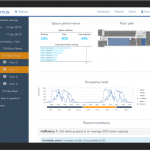 It’s tempting to think that the property world isn’t the most fertile when it comes to innovative uses of technology, yet the past few years have seen a number of nice applications of technology.
It’s tempting to think that the property world isn’t the most fertile when it comes to innovative uses of technology, yet the past few years have seen a number of nice applications of technology.
These include the easy configuration of interior spaces, the use of robots to make properties energy efficient, the use of drones to supervise building sites, houses made using 3D printing, temporary and portable housing in inner cities and even the automation of construction itself.
These, and other such advances, were chronicled in a recent report by academics from Birmingham University into the future of housing, which is embedded here.
It looked at various ways in which buildings are becoming smarter, with strong use of sensors and mobile technology to give us much greater control over our properties.
Real-time building analytics
Despite all of these advances, it’s probably fair to say that most buildings are still quite dumb. One startup that’s hoping to change things is UK based Animus.
Their software provides building managers with a dashboard that will show them the important metrics for their properties, including occupancy rates and the efficiency performance of the building.
“Animus uses sensors to continually monitor the number of people in each space throughout a building in real time,” co-founder Michael Ginzo said recently.
By using sensors, they can provide 24/7 coverage for a fraction of the cost of manual surveys. What’s more, by virtue of being digital, the data is easily accessible rather than holed up in files somewhere.
“Our dual hardware and software solution integrates with existing systems in the building to automate the provisioning of any people-dependent resource; from meeting room scheduling to heating, lighting and ventilation control. By understanding how the building is truly being used, Animus drives huge financial and environmental gains for occupiers,” Ginzo says.
Smart utilization
The AI that underpins the solution is capable of predicting future usage based upon previous patterns, thus giving managers the ability to intelligently manage everything from energy usage to staff distribution.
“Our aim is to use these predictions to make buildings operate in a more streamlined, effective and comfortable way for their occupants,” Ginzo tells me.
Whilst there have been various attempts made by building managers to better optimize their properties in the past, these have largely relied upon surveys to understand typical usage patterns.
Companies such as Animus highlight the move away from this towards more sensor based approaches that combine with AI to give smarter tools to managers.
The system has already been deployed in one facility, with the company hoping to grow rapidly from this startpoint.
Demand Logic
Another startup aiming to make building management smarter are Demand Logic. Their system collects data from over 100,000 sources throughout a building, before then applying its smart systems to make sense of this data.
It then produces a visual report of its findings together with some recommendations on how the building can be more efficiently run. It’s an interesting approach, and both startups are fine examples of how big data can be used to better manage the efficiency of our buildings.
You can check out more about Demand Logic via the video below.